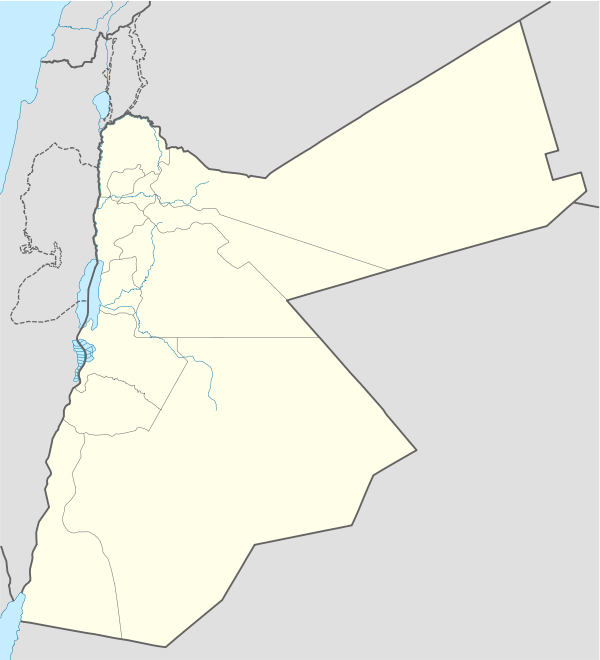Azraq, Jordan
Azraq (Arabic: الأزرق meaning "the blue") is a small town in Zarqa Governorate in central-eastern Jordan, 100 kilometres (62 mi) east of Amman. The population of Azraq was 9,021 in 2004.[1] The Muwaffaq Salti Air Base is located in Azraq.
Azraq الأزرق | |
|---|---|
Town | |
Ruins of Azraq Castle and a street in Azraq | |
 Azraq Location in Jordan | |
| Coordinates: 31°50′N 36°49′E | |
| Country | |
| Governorate | Zarqa |
| Government | |
| • Type | Municipality |
| • Mayor | Kamal Ata |
| Elevation | 525 m (1,722 ft) |
| Population (2004) | |
| • Total | 14,800 |
| Time zone | UTC+2 (UTC+2) |
| • Summer (DST) | UTC+3 (UTC+3) |
| Area code(s) | +(962)5 |
| Airports | Muwaffaq Salti Airbase |
History
Azraq has long been an important settlement in a remote and now-arid desert area of Jordan. The strategic value of the town and its castle (Qasr Azraq) is that it lies in the middle of the Azraq oasis, the only permanent source of fresh water in approximately 12,000 square kilometres of desert.
The town is located on a major desert route that would have facilitated trade within the region. The Azraq oasis has a long history beginning in the Lower Palaeolithic period. Many Palaeolithic sites have been documented in the Azraq Wetlands Reserve. During the Epipalaeolithic period the oasis was also an important focus of settlement.

Nabatean period settlement activity has also been documented in the area. Qasr Azraq was built by the Romans in the 3rd century AD, and was heavily modified in the Middle Ages by the Mameluks. In the Umayyad period a water reservoir was constructed in southern Azraq.
During the Arab Revolt in the early 20th century, Qasr Azraq was an important headquarters for T. E. Lawrence.[2][3]
The Azraq refugee camp, sheltering refugees of the Syrian Civil War, was opened in 2014 and is located 20 kilometres (12 mi) west of Azraq.[4] The site had been previously used during the Gulf War of 1990–91 as a transit camp for displaced Iraqis and Kuwaitis.[5]
Demographics
According to the Jordan National Census of 2004, the population of Azraq was 9,021, of whom 7,625 (84.5%) were Jordanian citizens. 4,988 (55.3%) were males, and 4,033 (44.7%) females. The next census was conducted in 2014.
Wildlife reserve

Azraq is also notable as being the site of one of Jordan's seven protected nature reserve areas (set up by the Royal Society for the Conservation of Nature): the Azraq Wetlands Reserve in Azraq al-Janoubi (South Azraq).
The separate and larger Shaumari reserve is also close to Azraq, being only 10 kilometres (6.2 mi) south of the town.
See also
References
- Department of Statistics-Jordan 2004 Census Archived 2011-07-22 at the Wayback Machine
- Lawrence, T.E. (1935). Seven Pillars of Wisdom. Garden City: Doubleday, Doran & Company, Inc. pp. 414, 434–436, 559, 582–587.
- Faulkner, Neil (2016). Lawrence of Arabia's War: The Arabs, the British and the Remaking of the Middle East in WWI. New Haven: Yale University Press. p. 273,367-368,426. ISBN 9780300226393.
- Hadid, Diaa; Akour, Omar (30 April 2014). "Azraq Refugee Camp Opens For 130,000 Syrians Fleeing War". The Huffington Post. Associated Press.
- Oddone, Elisa (30 April 2014). "Azraq Refugee Camp officially opened". The Jordan Times.
